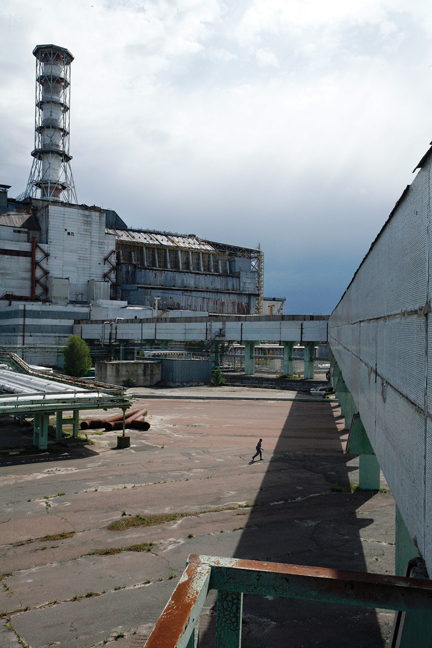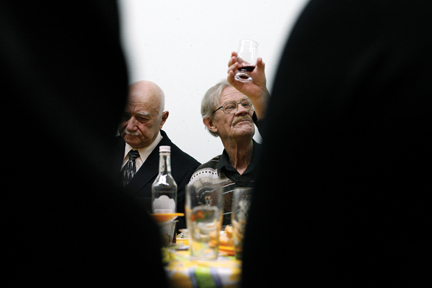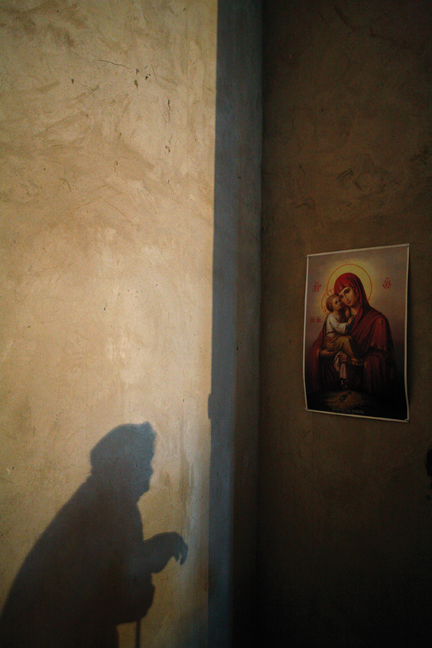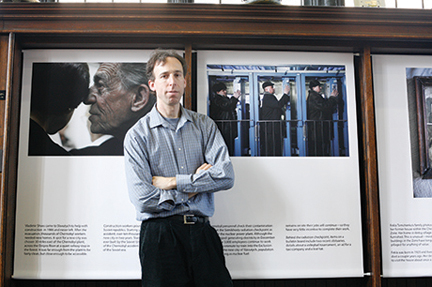Chernobyl Witness
“How can we deeply witness the pain of the world?” asks Quaker photojournalist Michael Forster Rothbart. “For me, it begins with listening fully.” In 2007, he moved to Ukraine and spent two years photographing Chernobyl survivors.

At the Chernobyl Nuclear Power Plant, a worker crosses in front of the Sarcophagus, the emergency concrete and lead structure built to enclose the ruins of the reactor hall after the 1986 meltdown. The massive central square is filled with overhead pipes, unused equipment, and abandoned buildings—as well as new radioactive waste treatment and storage facilities. Although the Central Square is inside a security fence and access is tightly restricted, it is far less contaminated than the adjacent “Local Zone” immediately west of the accident site.
BY THE TIME I GRADUATED FROM SWARTHMORE IN 1994, I HAD BURNED OUT AS AN ACTIVIST. I’d spent years telling people, stridently, what was wrong with the world, trying to change their ways. I rarely succeeded.
The next year, I left for India. I spent seven months volunteering and wandering, camera in hand. I loved photography but was not yet a photographer. In India, I first discovered that taking photos helps me see better. Slowing down enough to take photographs is a practice, like meditation, that helps us become more aware of what is right there in front of our eyes—or inside our minds.
That year, in a backwater village, I found my calling as a documentary photographer. It was 1996, and the World Bank was financing a dam on the Narmada River in Gujarat. Upstream, I met activists fighting the dam that would flood their homes. I photographed a quiet woman, Kamla Yadav, who announced she would drown in her yard rather than be forcibly resettled. She quoted a local slogan, Koi nahin hatega; bandh nahin banega: “No one will move; the dam will not be built.”
Later, after some of Yadav’s neighbors had indeed drowned and my portrait of her appeared in print, I realized that witnessing is what I should be doing—listening and using photos to tell human stories that would otherwise go unseen and unheard.
Today, I am equally a Quaker and a photojournalist, and these two tracks of my life cross-pollinate constantly. Both live as witnesses, and there are many parallels between photography and Quaker practice.
The first is in our intentions. We are searching for truth and insight, willing (ideally) to seek truth no matter where it leads us. We know the way may be hard, yet we persevere.
Another is in the skills required for bearing witness: an ability to observe quietly and contemplate, listen, and have compassion—for ourselves and others. The very act of listening compassionately, observing and recording someone’s daily life empowers those whose troubles have been ignored.

Members of the Ne Zdavaites! pensioners’ group gather to observe Red Army Day, a holiday originally dedicated to veterans of the Russian and Soviet Armed Forces and now simply referred to as Men’s Day. Ne Zdavaites! means Don’t Give Up! Most members are retirees from the Chernobyl power plant. Both men here are World War II veterans, but when local residents speak of “our war,” they mean Chernobyl.
Then there is being prepared for what we might encounter. Louis Pasteur said that “in the fields of observation, chance favors only the prepared mind.” We never know when the next decisive moment will arrive, but when it does we must be alert or it will moment will arrive, but when it does we must be alert or it will pass us by.
I cannot tell you how to be a witness; I can only describe how I have done it. In 2007, I moved to Ukraine and spent two years photographing Chernobyl survivors.
My commitment to this project began when I discovered how often photojournalists distort Chernobyl. They visit briefly, expecting danger and despair, and come away with photos of deformed children and abandoned buildings. This sensationalist approach obscures more complex stories of how displaced communities adapt and survive. Too often, we photojournalists operate more like an army, parachuting into a crisis, witnessing events, shooting until we bag the shot, taking no names, and moving on. Though sometimes the only option, such reportage is at best incomplete. It informs us of the events that happened, but not why they happened.
By contrast, I sought to create fuller portraits of these communities. There is suffering, but also joy and beauty, endurance and hope.

An elderly woman prays at the small Ukrainian church in Novo Ladizhichi village. Ukraine has seen a resurgence of interest in religion since the country gained independence in 1991. The church has been under construction for a decade and is decorated only with posters because villagers have had trouble raising money to complete it.
I made friends. I drank tea with Viktor. I drank vodka with my landlady Nina. I photographed my neighbors. Sasha, a recovering alcoholic, taught me how to cut hay. Slava, a doctor at the Chernobyl plant, taught me how to make borscht. I went to church. I went to the bar. I often wondered: If I had been born near Chernobyl, would I stay? I’m interested in questions about home. How do people cope when their homeland changes irreversibly? Today, I don’t have one definitive answer to this question; I have 82 contradictory answers. When we create the space and time to listen deeply, we soon get beyond the simplistic black-and-white, right-or-wrong construct of any issue. It then takes conscientious discernment and clear intentions before we can summarize accurately what we have witnessed and report it back to the world.
For many of the people I interviewed, losing their homes was as traumatic as the 1986 nuclear accident itself. I heard compelling stories about problems with alcoholism, mental illness, unemployment, medical care, birth defects, and corruption. Some overcome these difficulties; others surrender to them.
When we truly become witnesses, we don’t just observe the existing conditions of a situation. Inevitably, we become involved. Essentially, my photographs from Chernobyl are a visual diary. It is a mistake to think that I created an authoritative work on the subject. Witnessing is a deeply personal act, and we just have to hope that if we drill deep enough, we will find something universal.
What, then, did I find in Chernobyl? I saw that the people I met are not victims, mutants, or orphans. They are simply people struggling to live their lives—like you, like me.
I used to aspire to change the world with my photography. In time, I’ve understood that my witnessing is not about change but about reflection: I’m holding up a mirror. As photo editor Howard Chapnick wrote in Truth Needs No Ally, “Photojournalism has not stopped wars, eliminated poverty, or conquered disease, but neither has any other medium or institution…. Photography, as witness to history, gives testimony in the court of public opinion.”
I seek to engage the people and communities I photograph in frank discussions about their own local issues. My ultimate goal as a witness is not changing the world but reconciliation. This is something we all can do: listen to others as deeply as we listen for the Spirit within, then interpret and reflect those words so that others can hear as clearly as we have. For me, I can think of no work more important.
 Michael Forster Rothbart now lives in upstate New York, where he is documenting the effects of hydrofracking—the controversial method of extracting natural gas from deep shale deposits—on the lives of people there and in the hills of central Pennsylvania. It’s a project he first undertook on assignment for the October 2010 Bulletin. A longer version of this essay appeared in the May 2011 issue of Friends Journal. These Chernobyl photographs were exhibited in McCabe Library this spring. Text and photos ©2011 by Michael Forster Rothbart.
Michael Forster Rothbart now lives in upstate New York, where he is documenting the effects of hydrofracking—the controversial method of extracting natural gas from deep shale deposits—on the lives of people there and in the hills of central Pennsylvania. It’s a project he first undertook on assignment for the October 2010 Bulletin. A longer version of this essay appeared in the May 2011 issue of Friends Journal. These Chernobyl photographs were exhibited in McCabe Library this spring. Text and photos ©2011 by Michael Forster Rothbart. Email This Page
Email This Page